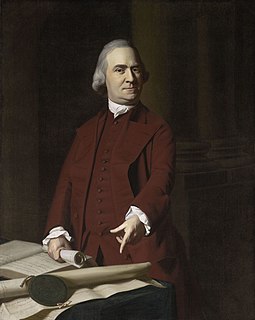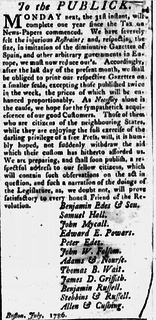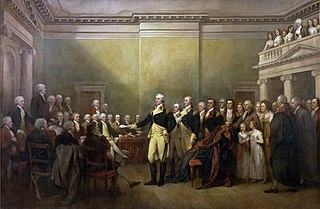
Paul Revere was an American silversmith, engraver, early industrialist, and Patriot in the American Revolution. He is best known for his midnight ride to alert the colonial militia in April 1775 to the approach of British forces before the battles of Lexington and Concord, as dramatized in Henry Wadsworth Longfellow's poem, "Paul Revere's Ride" (1861).

The Stamp Act of 1765 was an Act of the Parliament of Great Britain which imposed a direct tax on the British colonies in America and required that many printed materials in the colonies be produced on stamped paper produced in London, carrying an embossed revenue stamp. Printed materials included legal documents, magazines, playing cards, newspapers, and many other types of paper used throughout the colonies, and it had to be paid in British currency, not in colonial paper money.

Thomas Hutchinson was a businessman, historian, and a prominent Loyalist politician of the Province of Massachusetts Bay in the years before the American Revolution. He has been referred to as "the most important figure on the loyalist side in pre-Revolutionary Massachusetts". He was a successful merchant and politician, and was active at high levels of the Massachusetts government for many years, serving as lieutenant governor and then governor from 1758 to 1774. He was a politically polarizing figure who came to be identified by John Adams and Samuel Adams as a proponent of hated British taxes, despite his initial opposition to Parliamentary tax laws directed at the colonies. He was blamed by Lord North for being a significant contributor to the tensions that led to the outbreak of the American Revolutionary War.

The Province of New York (1664–1776) was a British proprietary colony and later royal colony on the northeast coast of North America. As one of the middle Thirteen Colonies, New York achieved independence and worked with the others to found the United States.

The Sons of Liberty was a loosely organized clandestine political organization active in the Thirteen American Colonies founded to advance the rights of the colonists and to fight taxation by the British government. It played a major role in most colonies in battling the Stamp Act in 1765. The group disbanded after the Stamp Act was repealed. However, the name was applied to other local separatist groups during the years preceding the American Revolution.

The Townshend Acts or Townshend Duties, refers to a series of British acts of Parliament passed during 1767 and 1768 relating to the British colonies in America. They are named after Charles Townshend, the Chancellor of the Exchequer who proposed the program. Historians vary slightly as to which acts they include under the heading "Townshend Acts", but five are often listed:

The Tea Act 1773 was an Act of the Parliament of Great Britain. The principal objective was to reduce the massive amount of tea held by the financially troubled British East India Company in its London warehouses and to help the struggling company survive. A related objective was to undercut the price of illegal tea, smuggled into Britain's North American colonies. This was supposed to convince the colonists to purchase Company tea on which the Townshend duties were paid, thus implicitly agreeing to accept Parliament's right of taxation. Smuggled tea was a large issue for Britain and the East India company, since approximately 86% of all the tea in America at the time was smuggled Dutch tea.

Andrew Oliver was a merchant and public official in the Province of Massachusetts Bay. Born into a wealthy and politically powerful merchant family, he is best known as the Massachusetts official responsible for implementing the provisions of the Stamp Act, for which he was hanged in effigy. He never actually carried out those duties, and was later commissioned as the province's lieutenant governor.

The Liberty Tree (1646–1775) was a famous elm tree that stood in Boston, Massachusetts near Boston Common, in the years before the American Revolution. In 1765, colonists in Boston staged the first act of defiance against the British government at the tree. The tree became a rallying point for the growing resistance to the rule of Britain over the American colonies, and the ground surrounding it became known as Liberty Hall. The Liberty Tree was felled in August 1775 by Loyalists led by Nathaniel Coffin Jr. or by Job Williams.
The Daughters of Liberty was the formal female association that was formed in 1765 to protest the Stamp Act, and later the Townshend Acts, and was a general term for women who identified themselves as fighting for liberty during the American Revolution.
Isaac Sears was an American merchant, sailor, Freemason, and political figure who played an important role in the American Revolution.

The Boston Tea Party was an American political and mercantile protest by the Sons of Liberty in Boston, Massachusetts, on December 16, 1773. The target was the Tea Act of May 10, 1773, which allowed the British East India Company to sell tea from China in American colonies without paying taxes apart from those imposed by the Townshend Acts. The Sons of Liberty strongly opposed the taxes in the Townshend Act as a violation of their rights. Protesters, some disguised as American Indians, destroyed an entire shipment of tea sent by the East India Company.

John Rowe (1715–1787) was a property developer and merchant in 18th century Boston, Massachusetts. As a merchant, John Rowe's most famous cargo was the tea that played a starring role in the Boston Tea Party. As a developer, his name is remembered to this day in the name of Rowes Wharf, a modern development in downtown Boston on the site of his original wharf.

Samuel Adams was an American statesman, political philosopher, and one of the Founding Fathers of the United States. He was a politician in colonial Massachusetts, a leader of the movement that became the American Revolution, and one of the architects of the principles of American republicanism that shaped the political culture of the United States. He was a second cousin to his fellow Founding Father, President John Adams.

Benjamin Edes was a journalist and political agitator. He is best known, along with John Gill, as the publisher of the Boston Gazette, a newspaper which sparked and financed the Boston Tea Party and was influential during the American Revolutionary War.

Then Province of Maryland had been a British / English colony since 1632, when Sir George Calvert, first Baron of Baltimore and Lord Baltimore (1579-1632), received a charter and grant from King Charles I of England and first created a haven for English Roman Catholics in the New World, with his son, Cecilius Calvert (1605-1675), the second Lord Baltimore equipping and sending over the first colonists to the Chesapeake Bay region in March 1634. The first signs of rebellion against the mother country occurred in 1765, when the tax collector Zachariah Hood was injured while landing at the second provincial capital of Annapolis docks, arguably the first violent resistance to British taxation in the colonies. After a decade of bitter argument and internal discord, Maryland declared itself a sovereign state in 1776. The province was one of the Thirteen Colonies of British America to declare independence from Great Britain and joined the others in signing a collective Declaration of Independence that summer in the Second Continental Congress in nearby Philadelphia. Samuel Chase, William Paca, Thomas Stone, and Charles Carroll of Carrollton signed on Maryland's behalf.

Pope Night was an anti-Catholic holiday celebrated annually on November 5 in the colonial United States. It evolved from the British Guy Fawkes Night, which commemorates the failure of the Gunpowder Plot of 1605. Pope Night was most popular in the seaport towns of New England, especially in Boston, where it was an occasion for drinking, rioting, and anti-elite protest by the working class.
The constitutional history of opposition to taxation is sufficiently interesting to be abstracted from broader contexts. Key action occurred in the Colony of Virginia in the decade before 1776. A particular protest document, arguably the most eloquent and most effective among many colonial protests, merits special attention.
Ebenezer Mackintosh was a shoemaker who lived in New England in the 18th and 19th centuries. He is known for his role as a mob leader in Boston riots protesting the Stamp Act.














